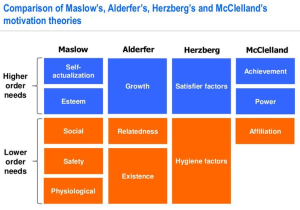Do you know what your employees really want from their job? Beyond the basics, understanding the key drivers of motivation, satisfaction, and engagement is crucial for building a thriving workplace.
The World Economic Forum summarises employee requirements from their job as:
1. Inclusion in decision making
2. Trust, autonomy and flexibility
3. Reskilling
4. Focus on employability
Creating a clearer picture, in general
The diagram below shows integrated view of the foundational thinking HR Practitioners have been using for the last few decades to inform Employee’s needs or wants.

Abraham Maslow (1943) introduced us to the foundation needs:
1. Physiological: the need for elements for basic survival such as food, water and shelter
2. Safety: the need to feel safe, both physically and emotionally, in your environment
3. Social: the emotional need for belongingness and connection to others
4. Esteem: the need to feel valued, respected and have a sense of self-worth
5. Self-actualisation: the need to realise your full potential and become the most that you can be
Alderfer’s ERG motivational model (1969 – when NASA put a man on the moon) simplifies Maslow’s hierarchy of needs into three core categories: Existence, Relatedness, and Growth, addressing human needs in a more flexible and overlapping manner
1. Existence Needs: These are the basic material and physiological needs required for survival, such as food, water, shelter, and safety.
2. Relatedness Needs: These needs involve interpersonal relationships and social interactions, including the desire for family, friends, and colleagues.
3. Growth Needs: These are the needs for personal development and self-fulfilment, encompassing the pursuit of creativity, competence, and achieving one’s potential.
Herzberg’s Two-Factor Theory (1957) posits that job satisfaction and dissatisfaction arise from two distinct sets of factors: hygiene factors (which prevent dissatisfaction) and motivators (which enhance satisfaction).
1. Motivators (Intrinsic Factors):
- Achievement: “Completing a challenging project successfully gives me a great sense of achievement.”
- Recognition: “Receiving recognition for my hard work motivates me to continue striving for excellence.”
- Work Itself: “I find the work itself to be engaging and fulfilling, which keeps me motivated.”
- Responsibility: “Being given more responsibility makes me feel trusted and valued.”
- Advancement: “Opportunities for advancement within the company inspire me to work harder.”
- Growth: “Personal and professional growth is essential for my long-term motivation and satisfaction.”
2. Hygiene Factors (Extrinsic Factors):
- Company Policies: “Clear and fair company policies help create a positive work environment.”
- Supervision: “Effective supervision ensures that I have the support and guidance I need.”
- Relationship with Supervisor: “A good relationship with my supervisor makes me feel more comfortable and supported at work.”
- Work Conditions: “Comfortable and safe work conditions are crucial for maintaining my productivity.”
- Salary: “A competitive salary is important for my financial stability and motivation.”
- Relationship with Peers: “Having a positive relationship with my peers makes the workplace more enjoyable.”
- Personal Life: “A healthy balance between work and personal life is essential for my overall well-being.”
- Status: “Feeling respected and having a certain status within the organization boosts my morale.”
- Security: “Job security is important for my peace of mind and long-term commitment to the company.”
Finally, McClelland’s Three Needs Theory, (1961) asserts that human behaviour is driven by three primary needs:
- Need for Affiliation (nAff): This need involves the desire for friendly and close interpersonal relationships, and being part of a group.
- Need for Power (nPow): This need is characterised by the desire to influence, control, and have authority over others.
- Need for Achievement (nAch) – This need drives individuals to excel, achieve in relation to a set of standards, and strive for success.
These theories have been validated in numerous organisations, but how would they impact yours?
- Addressing employees’ needs through these theories can enhance job satisfaction and reduce turnover.
- Understanding and applying motivational theories can lead to improved employee performance and productivity.
- Motivational theories help create a positive work environment that fosters higher levels of employee engagement.
- Implementing these theories can contribute to a supportive and motivating organisational culture.
- Leaders can use motivational theories to better understand and inspire their teams, leading to more effective management.
How can you determine what your team require?
- Remain observant
- Observe the work environment and interactions to identify potential issues or areas for improvement and pay attention to non-verbal cues and overall morale.
- Making the most of your one-on-one management meetings
- Determine if the employee has capacity to invest in more initiatives in the organisation, and if so, what would be stimulating or motivating for them
- Open Door Policy
- Encourage an open-door policy (accessibility) where employees feel comfortable approaching management with their concerns and ideas.
- Consider a suggestion box
- Provide a way for employees to submit suggestions anonymously – either physically or electronically, which you regularly review and act on any of the suggestions received.
- Interviews
- Conduct thorough exit-interviews to understand why employees are leaving and what could be improved and
- Conduct stay-interviews to understand why employees stay and what could make their experience better.
- Surveys and Questionnaires
- Make use of anonymous surveys to encourage honest feedback or release short, frequent (pulse) surveys to gauge employee sentiment over time.
- Establish Employee Committees
- Form committees with employee representatives to discuss and address workplace issues and hold regular meetings to ensure continuous dialogue.
Golden Guidelines:
- Act on Feedback: Ensure that feedback is acted upon to build trust and show employees that their opinions matter.
- Communicate Changes: Clearly communicate any changes or improvements made based on employee feedback.
- Follow-Up: Regularly follow up with employees to ensure that their needs are being met and to gather additional feedback.
If you would like to explore this topic more or require support to realise the benefits of of employee engagement in your organisation please contact us at info@adarehrm.ie or 01 561 3594
